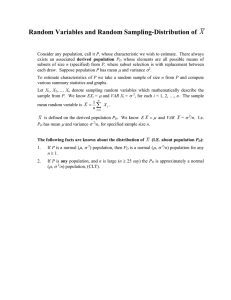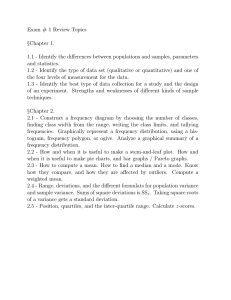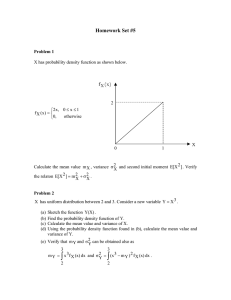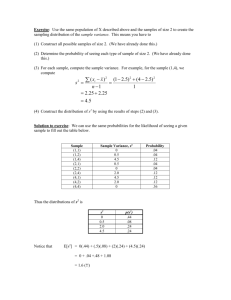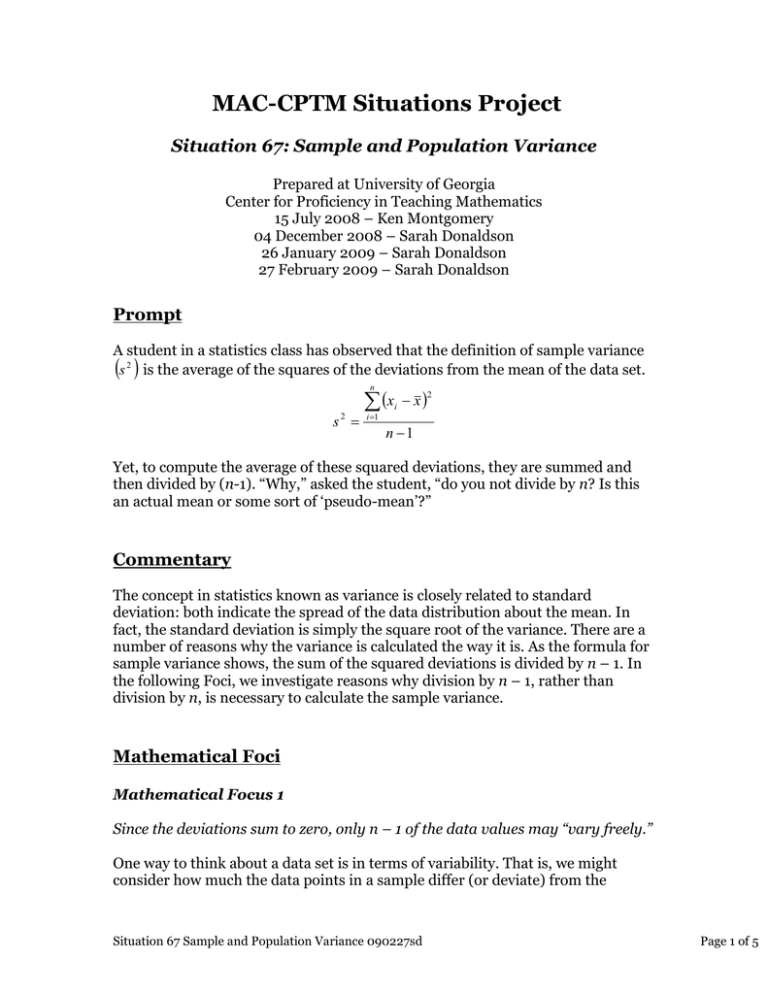
MAC-CPTM Situations Project
Situation 67: Sample and Population Variance
Prepared at University of Georgia
Center for Proficiency in Teaching Mathematics
15 July 2008 – Ken Montgomery
04 December 2008 – Sarah Donaldson
26 January 2009 – Sarah Donaldson
27 February 2009 – Sarah Donaldson
Prompt
A student in a statistics class has observed that the definition of sample variance
s 2 is the average of the squares of the deviations from the mean of the data set.
n
s2
x
i 1
x
2
i
n 1
Yet, to compute the average of these squared deviations, they are summed and
then divided by (n-1). “Why,” asked the student, “do you not divide by n? Is this
an actual mean or some sort of ‘pseudo-mean’?”
Commentary
The concept in statistics known as variance is closely related to standard
deviation: both indicate the spread of the data distribution about the mean. In
fact, the standard deviation is simply the square root of the variance. There are a
number of reasons why the variance is calculated the way it is. As the formula for
sample variance shows, the sum of the squared deviations is divided by n – 1. In
the following Foci, we investigate reasons why division by n – 1, rather than
division by n, is necessary to calculate the sample variance.
Mathematical Foci
Mathematical Focus 1
Since the deviations sum to zero, only n – 1 of the data values may “vary freely.”
One way to think about a data set is in terms of variability. That is, we might
consider how much the data points in a sample differ (or deviate) from the
Situation 67 Sample and Population Variance 090227sd
Page 1 of 5
sample mean, which may be interpreted as the balance point of the distribution
of the data. The deviation of a single data point, x, from the sample mean, x , is
simply the difference x x . The sum of all these differences must be 0 since the
sample mean, x , is the balance point. This can be seen algebraically. For
example, consider a data set of 3 values, x1, x2, and x3. The value of x is the
x1 x 2 x 3
arithmetic mean of these values: x
. This can be rewritten as
3
x1 x2 x3 3x . Now consider the sum of the deviations:
(x1 x ) (x2 x) (x3 x) . This can be rewritten as x1 x2 x3 3x . Since
x1 x2 x3 3x (see above),
x1 x2 x3 3x 0 , so the sum of the deviations is 0:
(x1 x) (x2 x) (x3 x) 0 .
to 0 to think about the role of n – 1 in
We can use the fact that the deviations sum
variance. Since the deviations sum to 0, if we know all but
the formula for sample
1 of them (that is, if we know n – 1 of them), the value of the last (i.e. the nth) term
is determined. In other words, only n – 1 of the data values may “vary freely.” In
statistics this is known as degrees of freedom: the number of data values that
have “freedom” to vary such that the mean remains the same.
For example, suppose we had a data set of 5 values and we know that x = 9.
There are many sets of 5 data values that have a mean of 9, but as soon as we
know 4 of them, the 5th is determined. One possibility is that 4 of the data values
are 5, 8, 12, and 13, as shown below.
x
x
5
9
8
9
12
9
13
9
?
9
xx
-4
-1
3
4
Given these 4 data values and their mean, we can determine the last data value.
Since the sum of the deviations is 0, we can find the last deviation, d:
-4 + -1 + 3 + 4 + d = 0
d = -2
Therefore the 5th data value is 7 since 7 – 9 = -2.
Why can we then conclude that the sample variance should be calculated by
dividing by n – 1? It is because we want to divide by the number of data values
that are independent (can vary freely)—i.e. we divide by the degrees of freedom.
By dividing by the degrees of freedom, the sample variance is an unbiased
estimate of the population variance.
Situation 67 Sample and Population Variance 090227sd
Page 2 of 5
Mathematical Focus 2
The sample variance is an unbiased estimator of the population variance.
If the expected value of the sample mean, x , is the same as the value of the mean,
, of the population from which the sample was taken, we say that the sample
mean is an unbiased estimate of the population mean. We may also talk about
bias as it relates to the variance of
a sample—that is, the biasness of the sample
2
variance, s , as an estimate of the population variance, 2. In calculating the
sample variance, dividing the sum of the squared deviations by n may seem
intuitive, but doing so will result in the sample variance being a biased estimate
of the population variance. In order for the sample variance to be an unbiased
estimate of the population variance, we must divide by n – 1 (called the degrees of
freedom—see Focus 1 and the Post Commentary).
The following example illustrates what would happen if we were to divide by n
when calculating the sample variance, rather than dividing by n – 1. The figure
below shows two dot plots—one in which n – 1 was used in the calculation (the
first plot, indicated by “Var(n-1)” and one in which n was used (indicated by
“Var(n)”).
Dotplot of Var(n-1), Var(n)
Var(n-1)
Var(n)
0
10
20
30
40
Data
50
60
70
Each symbol represents up to 6 observations.
In this example, a computer program was used to simulate taking 2000 samples,
with the size of each sample being n = 5. Note that this is a relatively low value for
n. This means the difference between n and n – 1 is large enough to illustrate the
Situation 67 Sample and Population Variance 090227sd
Page 3 of 5
point. (For very large values of n, the difference between n and n – 1 is minute.)
For the data in this example, it is known that the population variance, 2, is 16. So
to be an unbiased estimate of this population variance, we expect the value of the
sample variance to be s2 = 16. That is, the average value of the variance (i.e. the
average of all the data points in the dot plot above) should be at or near 16.
The statistics below indicate the actual average of these sample variances when
the variance is calculated using n – 1 and when it is calculated using n.
Descriptive Statistics: Var(n-1), Var(n)
Variable
Var(n-1)
Var(n)
N
2000
2000
Mean
16.126
12.901
We can see that the average sample variance when n – 1 is used is s2 =16.126 and
when n is used, the average sample variance is much too low: s2 = 12.901. Clearly
the calculation using n – 1 gives the better estimate of the true population
variance of 2 = 16, whereas a calculation using n will, on average, underestimate
the population variance.
Situation 67 Sample and Population Variance 090227sd
Page 4 of 5
Post Commentary
We can investigate the topic of an unbiased estimate by further considering the
concept of expected value. This may shed light on why we divide by n – 1 in
calculating the variance.
^
Definition: A statistic is an unbiased estimator of the parameter if and only
^
if E (in other words if the expected value of the statistic equals the
parameter).
Theorem: If S 2 is the variance of a random sample from an infinite population
with the finite variance 2 , then E S 2 2 .
Proof:
n
2
xi x
n
1 E x x 2
E ( S 2 ) E i 1
i
n 1 n 1 i 1
n
1
2
2
E xi n E x
n 1 i 1
Then, because E xi 2 and since E x
2
2
2
n
, we have that
1 n 2
2
2
n
n 1 i 1
n
and thus, by the definition, the sample variance is an unbiased estimator of the
population variance.▄
E S2
References
Agresti, A. & Franklin, C. (2007). Statistics: The art and science of learning from
data. Upper Saddle River, NJ: Pearson/Prentice Hall.
Freund, J. E. (1992). Mathematical Statistics (5th ed.). Upper Saddle River, NJ:
Prentice Hall.
Mendenhall, W., Beaver, R. J. & Beaver, B. M. (2005). Introduction to
Probability and Statistics (12th ed.). Pacific Grove, CA: Thomson
Brooks/Cole.
Situation 67 Sample and Population Variance 090227sd
Page 5 of 5

